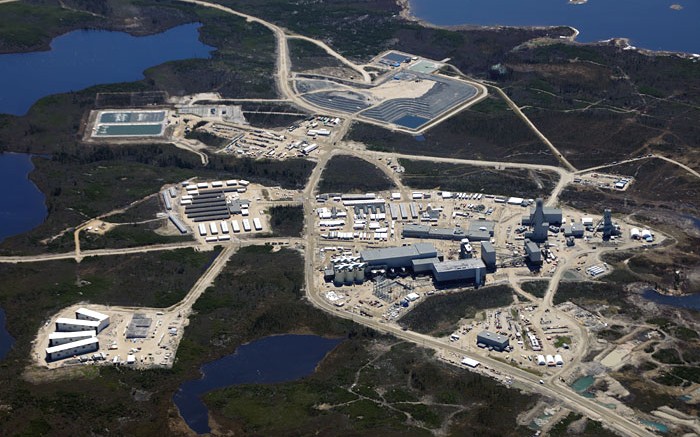By year-end, Goldcorp (TSX: G; NYSE: GG) will pour first gold from Éléonore — its first mine in Quebec.
Production for 2014 could reach 60,000 oz. gold and grow to nearly 350,000 oz. next year, with full production of 600,000 oz. per year by 2018.
At the Denver Gold Forum in September, Goldcorp president and CEO Chuck Jeannes said that construction at the underground mine — in the James Bay area of the province — was 93% complete and that the company was on schedule for 3,500-tonne-per-day commercial production by year-end.
However, Jeannes noted that Éléonore’s ramp-up would be slower than at its Cerro Negro mine in Argentina — a near-surface operation that Goldcorp is advancing toward full production.
Éléonore won’t really hit its stride until 2018, when it ramps up to full production of 7,000 tonnes per day, or 600,000 oz. gold a year.
Cerro Negro, meanwhile, will reach 500,000 oz. gold in 2015 — its first full year of production — not long after pouring its first gold mid-year.
“Now the ramp-up at Éléonore takes longer because it’s a vertical-dipping orebody and you have to develop at depth,” Jeannes said. “So we’re projecting to hit the average annual production after 2018 of 600,000 oz., which will make this one of Canada’s largest mines.”
While that’s impressive, with a decade-long mine life and a US$1.9-billion capital cost, Éléonore’s economics don’t look compelling.
In a technical report released in April that considers reserves only, the project’s internal rate of return is calculated at 3.2% after taxes, its net present value at a negative US$172 million and its projected payback period at eight years.
However, the report ignores inferred resources at Éléonore — which could double the mine life if they can be converted to reserves.
The project holds 4 million oz. gold in reserves, contained in 19.3 million tonnes grading 6.5 grams gold per tonne.
Éléonore contains another 4.1 million oz. in inferred resources contained in 13.3 million tonnes grading 9.63 grams gold per tonne. Both calculations use a cut-off grade of 3 grams gold per tonne, based on US$1,300 per oz. gold.
Aiming to grow reserves and resources, Goldcorp is conducting an intensive infill and exploration drilling at the project. Over the next three years, the company plans to drill 115,000 metres a year of exploration and delineation drilling.
In the second quarter alone, Goldcorp completed 22,855 metres of underground exploration and infill drilling in the lower parts of mine, with five diamond drill rigs.
Mineralization at Éléonore has been tested to 1,400 metres, but 85% of the reserves are above 600 metres deep.
“The deposit is now at 7 million oz. and growing, and we certainly haven’t seen the bottom of it, and we see a lot of opportunity on the lateral extent,” Jeannes says.
The mine’s economics are most sensitive to gold prices, which Jeannes believes will improve. Although the gold price dropped last year because investment demand tanked and physical demand growth couldn’t offset the drop, Jeannes said investment demand can’t fall much further.
“We are definitely bullish on the long-term gold price,” he said. “I don’t see how financial demand has a lot further down to go given the reduction of about 800 tonnes last year — so a lot of upside on the demand side.”
Jeannes continued: “On the supply side, we’ve talked about a peak gold scenario where, given the difficulty of finding and building new assets, I just don’t think that we’re going to see gold production ever at levels again that we see in 2014. So, all in all, it’s a good scenario for the gold price.”
Jeannes noted that Goldcorp is coming out of a period of intense capital spending on three development projects: Cerro Negro, Éléonore and the Cochenour deposit in Ontario. As the development projects become producing mines this year and next, capital spending will decrease and production and cash flow will grow.
“We are going to have improving financial returns, even in a flat gold-price environment,” Jeannes said.
In its second quarter, Goldcorp reported adjusted earnings of US$164 million, or US20¢ a share, which beat expectations.
Production guidance for the year is 2.95 to 3.1 million oz. gold.
The company is forecasting a 50% increase in gold production growth over next two years.
Reflecting some of that investment, Goldcorp’s all-in sustaining costs for 2014 are expected to average US$950 to US$1,000 per oz.
“I love the all-in sustaining cost metric — I think it provides transparency that we really need to show what it really costs to operate a mine,” Jeannes said. “But we have to be aware that you don’t buy new trucks every quarter or develop new drifts every quarter, so those costs can be kind of chunky.”
Jeannes has said that he favours Canada as a mining jurisdiction. Goldcorp launched a hostile bid for Quebec gold miner Osisko Mining for its Canadian Malartic open-pit mine in January, but lost to a higher friendly joint offer by Yamana Gold (TSX: YRI; NYSE: AUY) and Agnico Eagle Mines (TSX: AEM; NYSE: AEM)
Goldcorp has $1.2 billion in cash and equivalents.
The company’s shares recently traded at $26.11 in a 52-week trading range of $21.87 to $32.46. Goldcorp has 813.4 million shares outstanding.


Be the first to comment on "Goldcorp’s lonore to pour first gold in Q4"